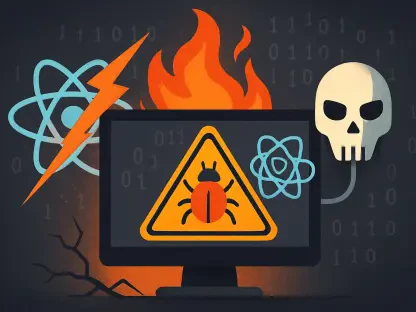In an era where digital threats loom larger than ever, charities find themselves increasingly vulnerable to cyber-attacks that can jeopardize their mission and the trust of those they serve, making the need for robust protection more critical than ever before. Recent reports highlight a startling rise in data breaches across sectors, with non-profit organizations often seen as easy targets due to limited resources for strong digital defenses. Imagine a small charity, dedicated to supporting vulnerable communities, suddenly losing access to donor funds or having sensitive beneficiary information exposed online. The financial and reputational fallout could be devastating, potentially derailing years of hard work. With cyber-crime becoming more sophisticated, the question arises: can charities afford to overlook the protection offered by cyber-security insurance? This critical safety net is no longer optional but a necessity to safeguard funds, data, and services. Exploring the reasons behind this urgent need reveals why such coverage has become indispensable for charities aiming to protect their invaluable work.
1. Rising Cyber Threats Targeting Charities
Charities, often perceived as having weaker digital security compared to corporate entities, have become prime targets for hackers seeking to exploit vulnerabilities. According to recent surveys, a significant percentage of charities—around 32%—have reported experiencing a cyber-attack or data breach. For larger organizations with incomes exceeding $500,000, this figure spikes to an alarming 66%. Phishing attacks, where fraudulent emails or messages trick staff into revealing sensitive information, remain the most common threat, affecting over 80% of impacted charities. These incidents underscore how cyber-criminals view non-profits as easy targets, assuming limited budgets restrict access to advanced security tools. The consequences extend beyond mere data loss, as breaches can disrupt essential services, leaving beneficiaries without critical support. This growing threat landscape highlights the urgent need for charities to prioritize digital protection to maintain their operations and protect their mission.
The impact of these cyber-attacks on charities is not just a matter of statistics but a real threat to their survival. A single breach can drain financial resources, with recovery costs depleting budgets meant for programs and outreach. Beyond monetary loss, the damage to reputation can be even more severe, as donors and partners may lose confidence in an organization’s ability to safeguard sensitive information. Beneficiaries, who often rely on charities for essential services, may also suffer when operations are halted due to a security incident. Unlike large corporations with dedicated IT teams, many charities operate with small staffs lacking specialized cyber-security training, making them more susceptible to sophisticated scams. This vulnerability emphasizes the importance of external support mechanisms, such as insurance, to mitigate risks that internal measures alone cannot fully address. As cyber-threats evolve, charities must adapt by recognizing their exposure and taking proactive steps to secure their digital assets.
2. Real-World Consequences of Cyber Breaches
The devastating effects of cyber-attacks on charities are evident in real-world cases where organizations have faced near closure due to financial theft. In a notable incident reported recently, a charity in the UK nearly shut down after scammers siphoned approximately $45,000 from its accounts. The breach occurred through a convincing phone scam, where a staff member was misled into providing access details under the guise of resolving a supposed account issue. By the time the deception was uncovered, the funds—crucial for sustaining operations—were gone. Such events illustrate how easily charities can fall prey to social engineering tactics, even with vigilant staff. The financial hit not only threatens day-to-day activities but also diverts resources from core missions to crisis management. This example serves as a stark reminder that without adequate safeguards, a single lapse can have catastrophic consequences for a charity’s stability and future.
Beyond immediate financial losses, the ripple effects of a cyber breach can erode the very foundation of a charity’s credibility. Public trust, often painstakingly built over years, can crumble overnight when donors learn that their personal data or contributions have been compromised. Legal ramifications may also arise, as charities could face penalties or lawsuits for failing to protect sensitive information, further straining limited budgets. Additionally, the time and effort required to rebuild systems, notify affected parties, and manage public relations can stall critical programs, leaving communities in need without support. Cyber-security insurance emerges as a vital tool in such scenarios, offering not just financial recovery but also access to expert guidance for navigating the aftermath of an attack. Without this protection, many charities risk being unable to recover from a breach, underscoring the pressing need to integrate such coverage into their risk management strategies.
3. The Role of Cyber-Security Insurance as a Safety Net
Despite the clear risks, a surprisingly low number of charities—only about 34% according to recent data—currently hold cyber-security insurance. This coverage is designed to alleviate the burden of a breach by covering costs related to technical recovery, legal counsel, and public relations efforts to manage reputational damage. For charities operating on tight budgets, these expenses can be crippling without insurance, diverting funds from essential services to damage control. Moreover, such policies often provide access to specialized support teams that can guide organizations through the complex process of incident response, from identifying the breach source to implementing fixes. This expert assistance is invaluable for charities lacking in-house IT expertise, ensuring that recovery is swift and effective. As cyber-threats become more frequent, having this financial and technical safety net is critical to maintaining operational continuity and donor confidence.
Cyber-security insurance also plays a broader role in enhancing a charity’s resilience and credibility in the eyes of stakeholders. By securing coverage, organizations signal to donors, funders, and partners that they are serious about protecting data and mitigating risks, which can strengthen trust and attract support. Additionally, many policies help cover liabilities related to third-party vendors or platforms, which are common sources of breaches for charities relying on external systems for fundraising or service delivery. While insurance cannot replace the need for robust cyber hygiene—such as staff training, updated malware protection, and two-factor authentication—it acts as a critical backup when preventive measures fail. Charities must view this coverage as an integral part of their risk management framework, ensuring they are prepared for the inevitable evolution of cyber-threats. This proactive approach not only safeguards resources but also reinforces a commitment to their core mission.
Safeguarding the Future of Charitable Missions
Reflecting on the challenges faced by charities in the digital age, it has become evident that cyber-attacks pose a significant threat to their sustainability over recent years. Many organizations have grappled with the harsh realities of data breaches and financial theft, which often left lasting scars on their operations and reputations. Yet, amidst these struggles, a path forward has emerged through the adoption of cyber-security insurance as a cornerstone of risk management. Charities that have taken steps to secure such coverage found themselves better equipped to handle crises, with financial support and expert guidance easing the burden of recovery. Moving ahead, the focus should shift to integrating practical security measures with comprehensive insurance plans to create a fortified defense against evolving threats. By prioritizing these actions, charities can ensure that their missions remain unhindered, protecting both their resources and the trust of the communities they serve with unwavering dedication.









